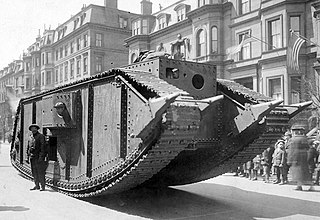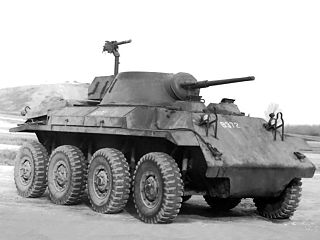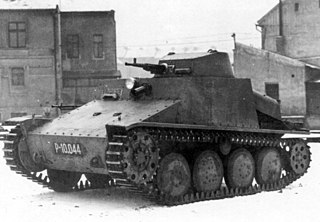
The M3 Scout Car was an American-produced armored car. The original M3 Scout Car was produced in limited numbers, while the improved M3A1 Scout Car saw wide service during World War II and after.

The Steam Tank (Tracked) was an early U.S. tank design of 1918 imitating the design of the British Mark IV tank but powered by steam.

The FV721 Fox Combat Vehicle Reconnaissance (Wheeled) was a 4 × 4 armoured car manufactured by ROF Leeds, deployed by the British Army as a replacement for the Ferret scout car and the Saladin armoured car. The Fox was introduced into service with B Squadron, 1st Royal Tank Regiment in 1975 and withdrawn from service 1993–94.

The Marmon-Herrington Armoured Car was a series of armoured vehicles that were produced in South Africa and adopted by the British Army during the Second World War. RAF Armoured Car companies possessed them, but seem never to have used them in action, making greater use of Rolls Royce Armoured Cars and other types.

An artillery tractor, also referred to as a gun tractor, is a specialized heavy-duty form of tractor unit used to tow artillery pieces of varying weights and calibres. It may be wheeled, tracked, or half-tracked.

The Willys MB and the Ford GPW, both formally called the U.S. Army Truck, 1⁄4-ton, 4×4, Command Reconnaissance, commonly known as the Willys Jeep, Jeep, or jeep, and sometimes referred to by its supply catalogue designation G503, were highly successful American off-road capable light military utility vehicles, built in large numbers to a single standardized design, for the United States and the Allied forces in World War II from 1941 until 1945.

The M35 2½-ton cargo truck is a long-lived 2½-ton 6×6 cargo truck initially used by the United States Army and subsequently utilized by many nations around the world. Over time it evolved into a family of specialized vehicles. It inherited the nickname "Deuce and a Half" from an older 2½-ton truck, the World War II GMC CCKW.

The T27 Armored Car was a prototype armored car developed for the US Army in 1944 by the Studebaker Corporation. The T27 was an eight-wheeled vehicle, with the first, second and fourth pairs of wheels being powered. With a crew of four, the T27 was armed with two .30 caliber machine guns and a 37 mm cannon. Powered by a Cadillac gasoline eight-cylinder engine, two T27's were produced in 1944.
Events from the 1310s in England.

HLA-DR13(DR13) is a HLA-DR serotype that recognizes the DRB1*1301 to *13082, *1310 and some other *13 gene products. DR13 serotype is a split antigen of the older HLA-DR6 serotype group which also contains the similar HLA-DR14 antigens.

The Nederlandse Spoorwegen (NS) Class 1300 was a Dutch locomotive in service for 48 years from 1952 until 2000.

The OA vz. 27 was a Czechoslovak-designed armored car used by Nazi Germany, Slovakia, and Romania during World War II. Fifteen were built, of which the Germans seized nine when they occupied Bohemia-Moravia in March 1939 and the Slovaks captured three when they declared independence from Czechoslovakia at the same time. Romania acquired three when Czech troops sought refuge in Romania after the Hungarian invasion of Carpatho-Ukraine that same month. All were used for training or internal security duties during the war.
Continental Motors Company was an American manufacturer of internal combustion engines. The company produced engines as a supplier to many independent manufacturers of automobiles, tractors, trucks, and stationary equipment from the 1900s through the 1960s. Continental Motors also produced automobiles in 1932–1933 under the name Continental Automobile Company. The Continental Aircraft Engine Company was formed in 1929 to develop and produce its aircraft engines, and would become the core business of Continental Motors, Inc.

Sd.Kfz. 247 schwerer geländegängiger gepanzerter Personenkraftwagen. was an armored car used by the German armed forces during World War II.

The AH-IV was a Czechoslovak-designed export armored fighting vehicle, classed as either a tankette or light tank, used by Romania during World War II, but having also been acquired by neutral Sweden and Iran. Modified AH-IV versions were built under license by Romania (R-1) and Sweden. The Romanian vehicles saw action on the Eastern Front from Operation Barbarossa to the Vienna offensive. Twenty vehicles were sold after the war to Ethiopia, who used them until the 1980s.
The Ottoman Military College or Imperial Military Staff College or Ottoman Army War College, was a two-year military staff college of the Ottoman Empire. It was located in Constantinople. Its mission was to educate staff officers for the Ottoman Army.
Henry II, Lord of Mecklenburg, nicknamed the Lion was regent of Mecklenburg from 1287 to 1298, co-regent from 1298 to 1302 and ruled alone again from 1302 to 1329.
Sir Antonio (di) Pessagno was a Genoese merchant and administrator. He is known mainly from his activities in England and France. He was the chief financier of King Edward II of England from 1312 until 1319.












